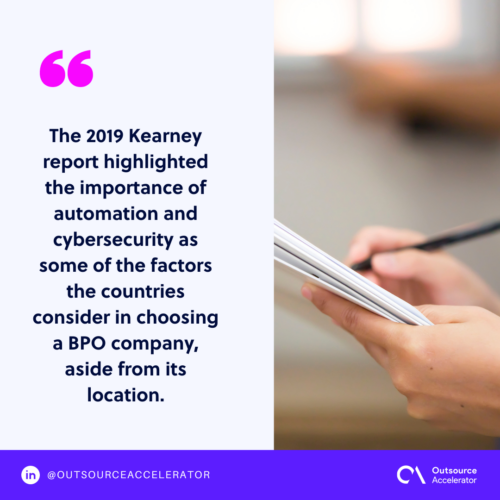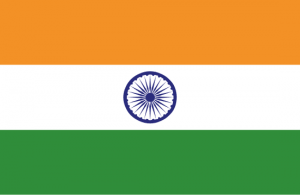Ultimate outsourcing statistics and reports in 2025

Business owners turn to business process outsourcing as a viable option instead of hiring in-house employees. The transition to the new normal even triggered the rapid change into remote work, which won’t always be viable with in-house workers alone.
With this, different institutions rank and name the top and emerging countries for outsourcing as a guide for businesses.
Despite the projection of the rise of disruptive outsourcing, companies are still more optimistic about the power of delegating tasks to the human workforce than their AI counterparts.
Even business process outsourcing (BPO) companies leverage automation to make their workload more efficient.
Nevertheless, the next few years will be more interesting for a globalized economy. Check out some key outsourcing statistics and reports in this comprehensive guide to project the industry’s future.
Global outsourcing statistics
On the verge of disruptive outsourcing and robotic process automation (RPA), companies still turn to the outsourcing and shared services (OSS) industry, with another emerging country to consider.
At the same time, global outsourcing companies race to implement AI and automated workflows to add value to their services.
As reported by Deloitte and a news article in the Arabian Gazette, OSS gained popularity in the Middle East, particularly in Dubai, and is projected to increase to $6.8 billion by 2023.
The 2019 Kearney report highlighted the importance of automation and cybersecurity as some of the factors the countries consider in choosing a BPO company, aside from its location.
This shift affected more repetitive jobs in low-cost countries, replacing these with highly-skilled ones to attend to the increasing demand for automation.

As per Gartner, more than 80% of logistics leaders planned to increase their outsourcing budget by more than 5% by 2020. One of the reasons for this is that outsourcing their logistics helped them a lot by meeting or exceeding the end-to-end (E2E) supply chain and overall business objectives.
The Everest Group, meanwhile, saw a 9-11% growth in the life and pension insurance BPO industry since end-to-end third-party administration grew. The industry has consistently grown 9-10% yearly since 2014.
Outsourcing industry statistics in the past 18 months
The new normal made companies understand the need to outsource their business processes more. Below are some of the updated global outsourcing revenue statistics and reports to date.
As the pandemic accelerated global businesses, companies have increased their competition by transferring to digitalized operations.
The US has the highest percentage of outsourced jobs globally, with almost 68% of companies delegating their services. The UK, meanwhile, has around 48% of companies offshoring business functions, with talent shortage as the main factor.
Deloitte’s global outsourcing survey revealed the three primary reasons businesses outsource their services today. These are:
- Cost reduction (84%)
- Standardization of processes (82%), and
- Development of capabilities (70%)
Healthcare is one of the most outsourced industries, with an increased need for remote and telehealth services.
As for the global outsourcing market, the industry has reached US$261.9 billion in 2022 and is still expected to grow at an annual rate of 9.4% by 2030. This statistic shows that outsourcing continues to be viable despite the rise of AI and robotic process outsourcing in businesses.
In terms of IT outsourcing efforts, companies will continue to utilize cloud solutions which are expected to reach “a monumental $760 billion” by 2027.
Meanwhile, cybersecurity remains one of global corporations’ leading concerns. This is especially true when acquiring remote workers. A reported rise in cybersecurity threats and data breaches has been reported in 2020 alone, making companies more worried about their data privacy and security.
With this, BPOs continue to strengthen their data security as BPOs and their clients make their long-term remote work strategy.
Top countries for outsourcing services
| Top countries for outsourcing | Most outsourced services |
| India | IT and software development |
| Philippines | Customer service, back office |
| United States | Tech support, IT-related services |
| Ukraine | IT outsourcing |
| Poland | IT and software development |
| Brazil | IT outsourcing |
| South Africa | Contact center, IT outsourcing |
| Malaysia | IT and software development |
Yearly, different research institutions list the top countries acquiring outsourced services. They usually base this on aspects such as workforce population, literacy rate, and access to the latest technology.
The following is an in-depth view of the top countries for outsourcing, the reason companies choose to outsource to them, and their specializations.
Indian offshore outsourcing statistics
India remains to be a top outsourcing destination worldwide.
The country reached the top most attractive location for offshore services based on Kearney‘s 2023 Global Location Services Index (GSLI) alongside China and Malaysia.
Aside from the 24/7 service and the latest technology, it prides its top talents, mostly specialized in IT and software development.
Highlights
- 2021 population: 1.40 billion
- Literacy rate: 74.37
- English proficiency: #50/100 in the world and #8/24 in Asia
- Employment rate (2021): 42.4
- Real GDP (in USD): 2.62 trillion
- Government support in outsourcing: full support to develop the IT industry
- Industry body: National Association of Software and Services Companies (NASSCOM)
Fast facts
- Gross Domestic Product (GDP). “India is the 3rd largest economy in the world after the US and China in terms of purchasing power parity (PPP) and 10th in terms of nominal GDP.” – Deloitte India
- Doing business. “India has moved 14 places to 63rd among 190 nations in the World Bank’s ease of doing business ranking on the back of multiple economic reforms by the Narendra Modi government.” – India Times
- Indian Railways. “Indian Railways is one of the largest employers in the world with over 1.4 million employees.” – MSN Money
- Labor statistics. “Slightly less than half of the workforce is in agriculture, but services are the major source of economic growth, accounting for nearly two-thirds of India’s output but employing less than one-third of its labor force.” – Forbes
- Action to climate change. “The country is paying its states about $125 per hectare of forest per year as a way to give afforestation a boost, one of their ways to tackle climate change.” – World Economic Forum
The Philippines offshore outsourcing statistics
Next to India, the Philippines is another leading outsourcing destination. The country, though considered a late bloomer, has held the title “The BPO Capital of the World” since 2010.
Being a former colony of Spain and the US gained them the advantage of cultural compatibility with more developed countries.
The country specializes in outsourcing customer service roles (voice and non-voice-related) and back-office services. Traditionally, multinational companies from various countries outsource call centers in the Philippines.
Besides cost reduction, businesses that outsource call centers in the country can fully leverage service quality. In turn, these companies can boost their core business.
Highlights
- 2021 population: 111.4 million
- Literacy rate: 98.18
- English proficiency: #27 in the world and #2 in Asia
- Employment rate (2021): 93.13
- Real GDP (in USD): 361.49 billion
- Government support in outsourcing: full support to develop the IT industry
- Industry body: IT & Business Process Association of the Philippines (IBPAP)
Fast facts
- Gross Domestic Product (GDP). “The Philippine Gross Domestic Product recorded a growth of 11.8% in the second quarter of 2021, the highest since its 12% recorded growth in 1988.” – Philippine Statistics Authority (PSA)
- “In 2015, the BPO sector generated over $22 billion in revenue, accounting for 7.3% of the Philippine economy.” – World Trade Organization
- “The income in the BPO industry was seen to ‘fill up remittance dip’ amid the onset of the pandemic in 2020.” – BusinessMirror
- Contribution of BPO to employment. “In the same year, the industry generated 1.2 million full-time employees.” – World Trade Organization
- Government support. As an encouragement to develop the IT sector in the Philippines, PEZA supports foreign investors in setting up BPO companies in the country by giving them incentives such as tax holidays, tax-free importation of equipment, and visa assistance.
The United States outsourcing statistics
Almost just recently, the outsourcing industry in the US started to get popular. Since 2017, domestic or onshore outsourcing services have become popular due to the massive pullout of companies.
The USA made it to Kearney’s top 10 destinations for outsourcing business services as more clients tap onshore teams for delegating their functions. The country is popular in tech support and IT-related services. Below are the remarkable US outsourcing statistics for this year.
Highlights
- 2021 population: 333.4 million
- Literacy rate: 99
- Employment rate (2021): 58.5
- Real GDP (in USD): 20.94 trillion
- Government support in outsourcing: slowly taking back a considerable number of jobs lost in the US to increase employment
- Fast facts
- Online work. “The US is the 3rd largest supplier of freelancers and online workers, next to India and Bangladesh.” – iLabour, Oxford Internet Institute
- Doing business. “In 2017, President Donald J. Trump Executive Order 13771, also known as the “one-in two-out” policy. It aims to cut costs in terms of doing business in the United States.” – US Environmental Protection Agency
- Fortune 500. “In total, Fortune 500 companies represent two-thirds of the U.S. GDP with $13.7 trillion in revenues, $1.1 trillion in profits, $22.6 trillion in market value, and employ 28.7 million people worldwide.” – Fortune.com
- Paris Agreement. “Months after being officially withdrawn from the Paris Agreement, the US rejoined the agreement on February 19, 2021, under the Biden administration.” – BBC
Ukraine offshore outsourcing statistics
The latest outsourcing statistics show that Ukraine is among the countries gaining outsourcing popularity in Eastern Europe. The country continuously receives recognition from institutions such as the Global Sourcing Association (GSA) in the UK, IAOP, and A. T. Kearney.
Outsourcing in the IT sector in the country is expected to increase in the following years, along with the increase in outsourced jobs.
Highlights
- 2021 population: 43.4 million
- Literacy rate: 99.97
- English proficiency: #44 in the world and #30 in Europe
- Employment rate: 56.2
- Real GDP (in USD): 155.6 billion
- Industry body: IT Ukraine Association
Fast facts
Agriculture. “Dubbed as the ‘breadbasket of Europe,’ Ukraine is first known for agricultural products such as sunflower and wheat.” – Ukraine Canadian Research and Documentation Centre
European Union. In 2017, Ukraine signed an agreement with the EU, Euratom, and the union’s 28 member states. This recognizes the country as a priority partner of the union. So far, Ukraine is not yet a part of the EU. – European Union External Action
IT outsourcing. “Developers in Ukraine are currently around 165,000 and are expected to increase up to 125% by 2025.” – Entrepreneur.com
Poland offshore outsourcing statistics
Another Eastern European country that has gained popularity in the outsourcing industry is Poland. It is one of the biggest players in IT in Eastern Europe, though it specializes in finance and accounting.
Aside from its multilingualism and cost reduction, outsourcing companies in the country have secured regulatory compliances from different institutions to ensure top data security for their outsourcing partners.
Presented below are Poland’s current outsourcing statistics:
Highlights
- 2021 population: 37.79 million
- Literacy rate: 99.8
- English proficiency: #16 in the world and #14 in Europe
- Employment rate (2021): 69.2
- Real GDP (in USD): 594.2 billion
- Industry body: Association of Business Service Leaders (ABSL)
Fast facts
- Economy. “Poland is now among the fastest-growing economies in the European Union (EU), recording a GDP growth of 5.1% in 2018.” – World Bank
- Demographic outlook. “…The 15-to-59 age segment is expected to decline by 2.7 million by 2025. This trend can, however, be stopped or even reversed, with targeted policy measures.” – McKinsey
- Ease of doing business. “Poland ranks 40th in the World Bank’s Ease of Doing Business ranking and has the lowest corruption score in Eastern Europe.” – Statista
- Cybersecurity. “The Polish National Cyber Security Strategy aims to enhance capacity to counteract cybercrime, including cyber espionage and incidents of a terrorist nature, occurring in cyberspace.” – EU
Brazilian offshore outsourcing statistics
Outsourcing in Brazil has been made unrestricted thanks to the Outsourcing law, which was signed in 2017, and the Supreme Court decision the following year.
Now more companies outsource their core business functions in the country besides secondary services such as janitorial roles.
To date, the country ranks 4th best outsourcing destination in Kearney’s 2023 Global Services Location Index.
Highlights
- 2021 population: 213.3 million
- Literacy rate: 93.2
- English proficiency: #53 in the world and #10 in Latin America
- Employment rate (2021): 50.2
- Real GDP (in USD): 1.45 trillion
- Industry body: Brazilian Association of Software Companies (ABES)
Fast facts
Overview. “Brazil is South America’s most influential country, a rising economic power and one of the world’s biggest democracies.” – BBC
GDP savings action plan. “A comprehensive social security reform was sent to the Congress in February and approved by the lower house in August. The reform is expected to generate accumulated savings of 9 percent of GDP until 2030, combined with the spending rule. It would stabilize the general government gross debt at around 81.7 percent of GDP by 2023.” – World Bank
Economic reform policies. “Some progress has been made in reducing trade barriers by limiting local content requirements in the oil and gas sector…” – OECD
South African offshore outsourcing statistics
Ranked 12th in Tholons Digital Nations, South Africa is now the third-largest emerging BPO geography, competing with India and the Philippines.
The BPO industry in the country is also credited for contributing to economic and social growth with the help of impact sourcing.
South Africa specializes in contact center and IT outsourcing, with most of its clients in banking and finance, telecommunications, and the healthcare industry.
Highlights
- 2021 population: 60.24 million
- Literacy rate: 99.37
- English proficiency: #12 in the world and #1 in Africa
- Employment rate (2021): 37.7
- Real GDP (in USD): 301.9 billion
- Industry body: Business Process Enabling South Africa (BPESA)
Fast facts
- Economy. “South Africa has one of the continent’s biggest and most developed economies.” – BBC
- The country ranks second-largest economy, next to Nigeria. – IMF
- Production. “South Africa is one of the world’s largest producers and exporters of gold, platinum, and other natural resources.” – Economic Freedom Index
- Innovation. “South Africa leads the regional ranking of the 2019 Global Innovation Index, making it the most innovative country in Africa.” – WIPO
Malaysian offshore outsourcing statistics
Last but not least, Malaysia is a rising country for outsourcing. The same 2023 report from Kearney placed Malaysia as the third-best outsourcing destination in the world.
The country has been gaining popularity in the IT outsourcing industry and IT-related outsourced tasks.
However, it must keep up with its neighboring countries regarding infrastructure and English proficiency.
Highlights
- 2021 population: 32.7 million
- Literacy rate: 98.74
- English proficiency: #30 in the world and #3 in Asia
- Employment rate (2021): 68.3
- Real GDP (in USD): 336.7 billion
- Industry body: Outsourcing Malaysia (OM)
Fast facts
- Economy. “Malaysia is one of the most open economies in the world, with a trade to GDP ratio averaging over 130 percent since 2010.” – World Bank
- Monarchical ruling. “Since Malaysia’s independence in 1957, the sultans who are the hereditary monarchs in nine of the country’s 13 states have selected one of themselves to serve a five-year term as king.” – CNN
- Small and medium enterprises (SMEs). 98.5% of business establishments in Malaysia are SMEs. In 2017, they contributed 37.1% of the country’s GDP. – Department of Statistics Malaysia
- Censorship. “Malaysia has some of the toughest censorship laws in the world. The authorities exert substantial media controls and can impose restrictions in the name of national security.” – BBC















 Independent
Independent




